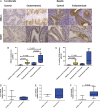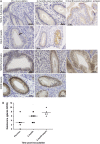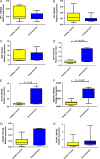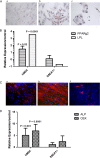Abnormally located SSEA1+/SOX9+ endometrial epithelial cells with a basalis-like phenotype in the eutopic functionalis layer may play a role in the pathogenesis of endometriosis
- PMID: 30496412
- PMCID: PMC6295963
- DOI: 10.1093/humrep/dey336
Abnormally located SSEA1+/SOX9+ endometrial epithelial cells with a basalis-like phenotype in the eutopic functionalis layer may play a role in the pathogenesis of endometriosis
Abstract
Study question: Is endometriosis associated with abnormally located endometrial basalis-like (SSEA1+/SOX9+) cells in the secretory phase functionalis and could they contribute to ectopic endometriotic lesion formation?
Summary answer: Women with endometriosis had an abnormally higher number of basalis-like SSEA1+/SOX9+ epithelial cells present in the stratum functionalis and, since these cells formed 3D structures in vitro with phenotypic similarities to ectopic endometriotic lesions, they may generate ectopic lesions following retrograde menstruation.
What is known already: Endometrial basalis cells with progenitor potential are postulated to play a role in the pathogenesis of endometriosis and SSEA1 and nuclear SOX9 (nSOX9) mark basalis epithelial cells that also have some adenogenic properties in vitro. Induction of ectopic endometriotic lesions in a baboon model of endometriosis produces characteristic changes in the eutopic endometrium. Retrograde menstruation of endometrial basalis cells is proposed to play a role in the pathogenesis of endometriosis.
Study design, size, duration: This prospective study included endometrial samples from 102 women with and without endometriosis undergoing gynaecological surgery and from six baboons before and after induction of endometriosis, with in vitro assays examining the differentiation potential of human basalis-like cells.
Participants/materials, setting, methods: The study was conducted at a University Research Institute. SSEA1 and SOX9 expression levels were examined in human endometrial samples from women aged 18-55 years (by immunohistochemistry (IHC) and qPCR) and from baboons (IHC). The differential gene expression and differentiation potential was assessed in freshly isolated SSEA1+ endometrial epithelial cells from women with and without endometriosis (n = 8/group) in vitro. In silico analysis of selected published microarray datasets identified differential regulation of genes of interest for the mid-secretory phase endometrium of women with endometriosis relative to that of healthy women without endometriosis.
Main results and the role of chance: Women with endometriosis demonstrated higher number of basalis-like cells (SSEA1+, nSOX9+) in the functionalis layer of the eutopic endometrium compared with the healthy women without endometriosis in the secretory phase of the cycle (P < 0.05). Induction of endometriosis resulted in a similar increase in basalis-like epithelial cells in the eutopic baboon endometrium. The isolated SSEA1+ epithelial cells from the eutopic endometrium of women with endometriosis had higher expression of OCT4, NANOG, FUT4 mRNA (P = 0.05, P = 0.007, P = 0.018, respectively) and they differentiated into ectopic endometriotic gland-like structures in 3D culture, but not into mesodermal lineages (adipose or bone cells).
Large scale data: N/A.
Limitations, reasons for caution: Small sample size. Bioinformatics analysis and results depends on the quality of published microarray datasets and the stringency of patient selection criteria employed. Differentiation of SSEA-1+ cells was only examined for two mesodermal lineages (adipogenic and osteogenic).
Wider implications of the findings: Since endometrial epithelial cells with SSEA1+/nSOX9+ basalis-like phenotype generate endometriotic gland-like structures in vitro, they may potentially be a therapeutic target for endometriosis. An in depth analysis of the function of basalis-like eutopic endometrial epithelial cells might provide insights into their potential deregulation in other disorders of the endometrium including heavy menstrual bleeding and endometrial cancer where their function may be aberrant.
Study funding/competing interest(s): We acknowledge the support by Wellbeing of Women project grant RG1073 (D.K.H., C.E.G.) and R01 HD083273 from the National Institutes of Health (A.T.F.). We also acknowledge the support of Liverpool Women's Hospital Foundation Trust (J.D.), Institute of Translational Medicine (L.D.S., H.A.L., A.J.V., D.K.H.), University of Liverpool, the National Health and Medical Research Council of Australia ID 1042298 (C.E.G.) and the Victorian Government Operational Infrastructure Support Fund. All authors declare no conflict of interest.
Figures






Similar articles
-
SSEA-1 isolates human endometrial basal glandular epithelial cells: phenotypic and functional characterization and implications in the pathogenesis of endometriosis.Hum Reprod. 2013 Oct;28(10):2695-708. doi: 10.1093/humrep/det285. Epub 2013 Jul 11. Hum Reprod. 2013. PMID: 23847113
-
N-cadherin identifies human endometrial epithelial progenitor cells by in vitro stem cell assays.Hum Reprod. 2017 Nov 1;32(11):2254-2268. doi: 10.1093/humrep/dex289. Hum Reprod. 2017. PMID: 29040564
-
In silico, in vitro and in vivo analysis identifies a potential role for steroid hormone regulation of FOXD3 in endometriosis-associated genes.Hum Reprod. 2016 Feb;31(2):345-54. doi: 10.1093/humrep/dev307. Epub 2015 Dec 23. Hum Reprod. 2016. PMID: 26705148
-
Endometrial stem/progenitor cells: the first 10 years.Hum Reprod Update. 2016 Mar-Apr;22(2):137-63. doi: 10.1093/humupd/dmv051. Epub 2015 Nov 9. Hum Reprod Update. 2016. PMID: 26552890 Free PMC article. Review.
-
Adenomyosis pathogenesis: insights from next-generation sequencing.Hum Reprod Update. 2021 Oct 18;27(6):1086-1097. doi: 10.1093/humupd/dmab017. Hum Reprod Update. 2021. PMID: 34131719 Free PMC article. Review.
Cited by
-
Long-term maintenance of human endometrial epithelial stem cells and their therapeutic effects on intrauterine adhesion.Cell Biosci. 2022 Oct 18;12(1):175. doi: 10.1186/s13578-022-00905-4. Cell Biosci. 2022. PMID: 36258228 Free PMC article.
-
The Role of Endometrial Stem/Progenitor Cells in Recurrent Reproductive Failure.J Pers Med. 2022 May 11;12(5):775. doi: 10.3390/jpm12050775. J Pers Med. 2022. PMID: 35629197 Free PMC article. Review.
-
Endometriosis and the Fallopian Tubes: Theories of Origin and Clinical Implications.J Clin Med. 2020 Jun 18;9(6):1905. doi: 10.3390/jcm9061905. J Clin Med. 2020. PMID: 32570847 Free PMC article. Review.
-
Establishment of Adenomyosis Organoids as a Preclinical Model to Study Infertility.J Pers Med. 2022 Feb 4;12(2):219. doi: 10.3390/jpm12020219. J Pers Med. 2022. PMID: 35207707 Free PMC article.
-
In-vitro models of human endometriosis.Exp Ther Med. 2020 Mar;19(3):1617-1625. doi: 10.3892/etm.2019.8363. Epub 2019 Dec 20. Exp Ther Med. 2020. PMID: 32104212 Free PMC article. Review.
References
-
- Blumenkrantz MJ, Gallagher N, Bashore RA, Tenckhoff H. Retrograde menstruation in women undergoing chronic peritoneal dialysis. Obstet Gynecol 1981;57:667–670. - PubMed
-
- Bulun SE, Cheng YH, Yin P, Imir G, Utsunomiya H, Attar E, Innes J, Kim JJ. Progesterone resistance in endometriosis: link to failure to metabolize estradiol. Mol Cell Endocrinol 2006;248:94–103. - PubMed
-
- Burney RO, Talbi S, Hamilton AE, Vo KC, Nyegaard M, Nezhat CR, Lessey BA, Giudice LC. Gene expression analysis of endometrium reveals progesterone resistance and candidate susceptibility genes in women with endometriosis. Endocrinology 2007;148:3814–3826. - PubMed
Publication types
MeSH terms
Substances
Grants and funding
LinkOut - more resources
Full Text Sources
Other Literature Sources
Medical
Research Materials

